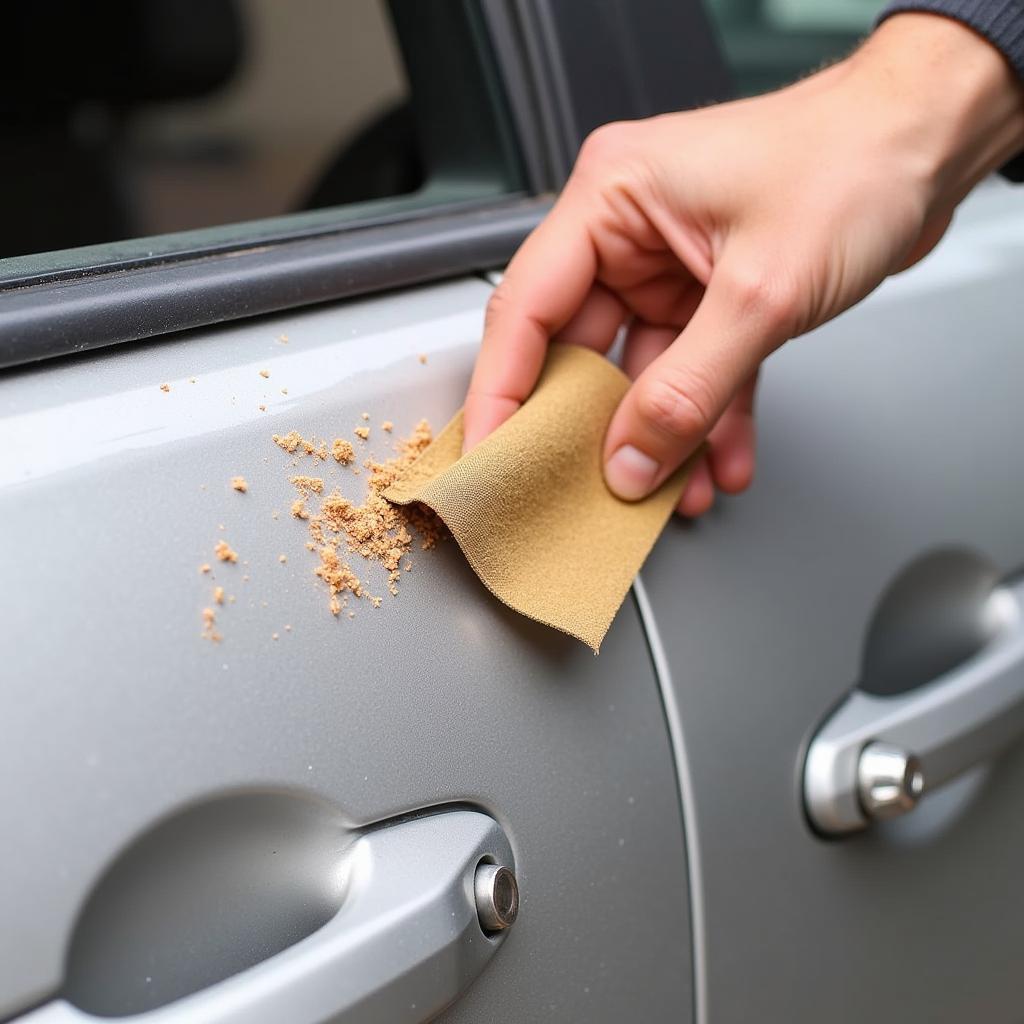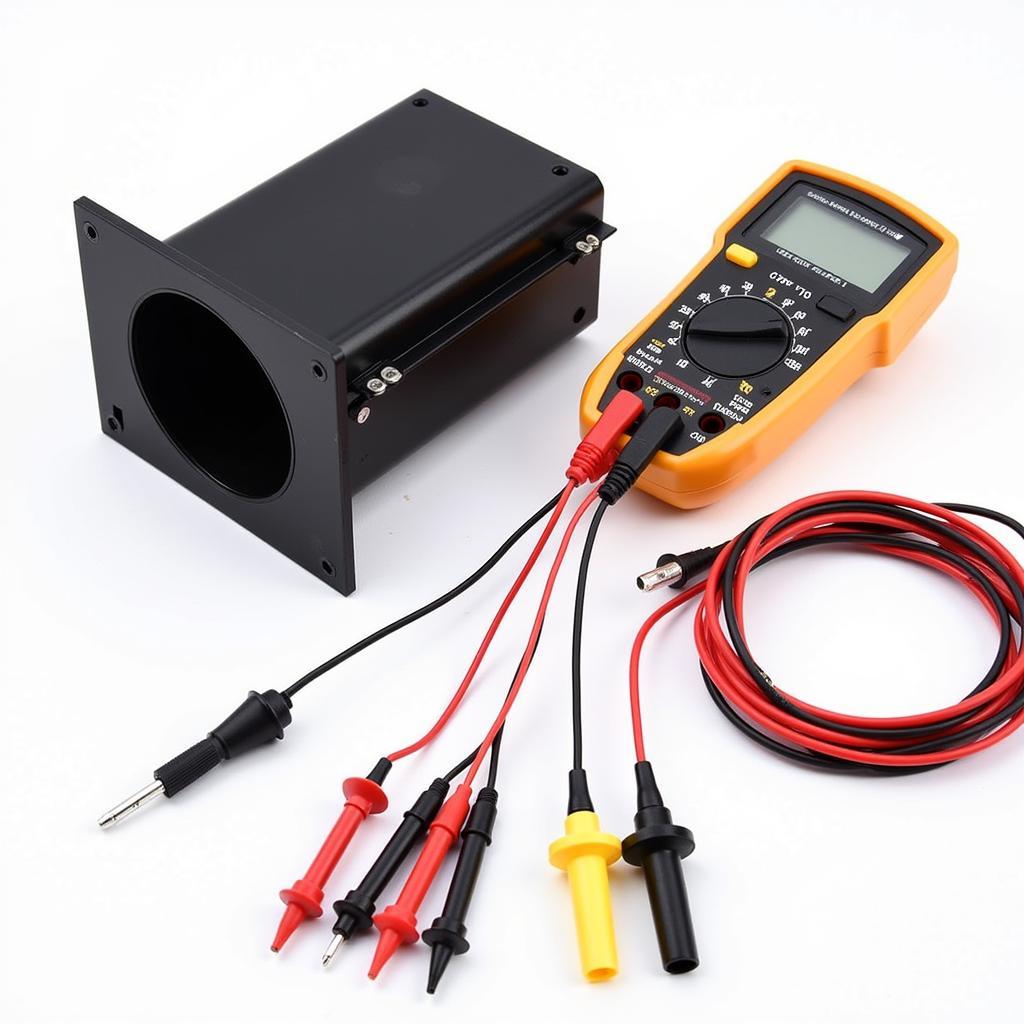Rust on your car door isn’t just unsightly; it’s a creeping menace that can compromise the structural integrity of your vehicle. This guide will provide you with a comprehensive, step-by-step approach on How To Fix A Rust Spot On Car Door, saving you potentially expensive body shop bills.
Rust is like a cavity in your car’s “teeth.” Left unchecked, it will spread and cause significant damage. But just like a dentist can fix a cavity, you can tackle rust spots before they become major problems. Addressing these issues promptly can also improve the resale value of your vehicle. Learn how to stop rust in its tracks and restore your car door to its former glory. You can find valuable information on fixing car leaks as well, a common issue related to rust and vehicle maintenance.
Understanding the Enemy: Why Does Rust Form?
Rust, chemically known as iron oxide, forms when iron or steel is exposed to moisture and oxygen. Your car door, being predominantly steel, is susceptible to this chemical reaction. Chips in the paint, scratches, and even road salt can accelerate the rusting process.
Different Types of Rust
Not all rust is created equal. Understanding the type of rust you’re dealing with helps determine the appropriate course of action.
- Surface Rust: This is the initial stage, appearing as small, reddish-brown spots. It hasn’t penetrated deeply yet and is relatively easy to address.
- Scale Rust: As surface rust progresses, it forms a flaky, scaly layer. This requires more aggressive treatment than surface rust.
- Penetrating Rust: This is the most severe type, where the rust has eaten through the metal. It often requires patching or even replacing the affected panel.
How to Fix Surface Rust on a Car Door
 Fixing Surface Rust on a Car Door
Fixing Surface Rust on a Car Door
Dealing with surface rust is a manageable DIY project. Here’s how to fix a rust spot on car door in its early stages:
- Gather your supplies: You’ll need sandpaper (various grits), masking tape, primer, paint that matches your car’s color, clear coat, and a rubbing compound.
- Prepare the area: Wash the affected area thoroughly with soap and water. Dry it completely.
- Sand the rust: Start with a coarser grit sandpaper (around 180-grit) to remove the rust. Work your way up to a finer grit (320-grit) to smooth the surface. Feather the edges of the sanded area to blend it with the surrounding paint.
- Mask the surrounding area: Use masking tape and paper to protect the areas you don’t want to paint.
- Prime the sanded area: Apply a thin, even coat of automotive primer. Let it dry completely.
- Paint: Apply several thin coats of paint that matches your car’s color. Allow each coat to dry before applying the next.
- Clear coat: Apply a few coats of clear coat to protect the paint and give it a glossy finish.
- Finishing touches: Once the clear coat is dry, use a rubbing compound to blend the repaired area seamlessly with the rest of the car door.
Tackling Scale Rust: A More Aggressive Approach
Scale rust requires a more robust approach:
- Rust Converter: Apply a rust converter to the affected area. This chemical solution converts the rust into a stable, paintable surface.
- Follow steps 2-8 from the surface rust removal process.
If you’re unsure about how to fix a car that idles poorly, which can sometimes be related to vacuum leaks, check out our detailed guide. Addressing such issues promptly can prevent further damage.
When Rust Goes Deep: Penetrating Rust Repair
Penetrating rust is a serious issue and often requires professional repair. However, small areas can be addressed with fiberglass body filler. For larger areas, patching or replacement of the affected panel might be necessary. Dealing with deep rust can be challenging. Learn more about finding and fixing car oil leaks to prevent rust formation caused by oil exposure.
Expert Insight: “Catching rust early is key,” says David Miller, Automotive Engineer at Miller Automotive Solutions. “Regular inspections and prompt treatment can prevent minor rust spots from becoming major headaches.”
Preventing Rust: Protecting Your Investment
Preventing rust is always better than curing it. Regular washing and waxing, touching up paint chips promptly, and storing your car in a garage can significantly reduce the risk of rust formation.
Expert Insight: “Think of waxing your car like applying sunscreen,” adds Maria Sanchez, Auto Body Specialist at Sanchez Auto Body. “It creates a protective barrier against the elements.”
Conclusion
Knowing how to fix a rust spot on car door is an essential skill for every car owner. By addressing rust promptly and implementing preventive measures, you can keep your car looking its best and protect its value. Remember, early intervention is key. If you’re uncomfortable tackling rust repair yourself, consult a qualified auto body professional. Need help with other car repairs like figuring out how much to fix a car? Contact us at Autotippro for expert advice.
Need Assistance? Connect with AutoTipPro at +1 (641) 206-8880 or visit our office at 500 N St Mary’s St, San Antonio, TX 78205, United States.
FAQ
- What causes rust on car doors? Rust forms when iron or steel is exposed to moisture and oxygen.
- How can I prevent rust on my car? Regular washing, waxing, and promptly touching up paint chips can help prevent rust.
- What tools do I need to fix surface rust? Sandpaper, masking tape, primer, paint, clear coat, and rubbing compound are essential.
- Can I repair penetrating rust myself? Small areas can be addressed with fiberglass body filler, but larger areas often require professional repair.
- What is a rust converter? A rust converter is a chemical solution that converts rust into a stable, paintable surface.
- How much does it cost to fix a vacuum leak? Check out our article on how much to fix a vacuum leak on my car for more details.
- When should I seek professional help for rust repair? If you’re unsure about the extent of the rust or uncomfortable tackling the repair yourself, consult a professional.





Leave a Reply